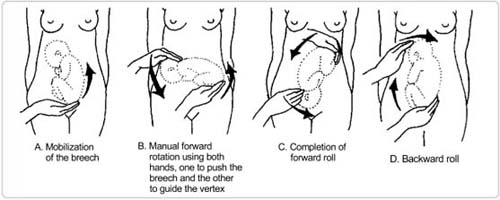Caesarean Section
What is it?
You obstetrician and yourself have discussed how your baby should be delivered. The risks of delivering the baby through the vagina are greater than if you were delivered by an elective Caesarean section. Elective means that the operation is not an emergency. Common reasons for a Caesarean section are high blood pressure, small pelvis, baby in distress, baby in the breech (bottom first) position, twins, or triplets. It will be safer if your baby is brought out through a cut in your tummy and womb. The operation is usually arranged to take place a week to 10 days before the date your baby is due. If you go into labour before this, it will be done as an emergency. The hospital is ready for this type of operation to be done any time, day or night.

The Operation
You will either have a general anaesthetic and be asleep during the operation, or be made numb from the waist down with an injection in the back. This is an epidural anaesthetic. You will be awake, but will not feel any pain. The surgeon makes a cut in the lower part of your tummy. This will normally be a "bikini" incision just above the hair line. If he/she thinks he will need more space, or if you have had other surgery there already, the surgeon may need to make an "up and down" cut below the tummy button. He will discuss this with you before your operation. Your womb is opened, and your baby and the afterbirth (placenta) are brought out. Your womb and your tummy are then stitched up. You will be in hospital for about six days.
Any Alternatives
The decision to deliver your baby/babies by Caesarean section has been made by your obstetrician and yourself. If you are unhappy with this decision or need further information as to why the decision has been made, then you should speak to your midwife or general practitioner. They will either answer your questions or arrange for you to meet with your obstetrician again.
Before the operation
Ideally, your partner should come with you to the hospital for the operation and look after you after that. If this is not possible, check that you have a relative or friend who can come with you to the hospital, take you home, and look after you for the first week after the operation. Sort out any tablets, medicines, inhalers that you are using. Keep them in their original boxes and packets. Bring them to hospital with you. On the ward, you may be checked for past illnesses and may have special tests to make sure that you are well prepared and that you can have the operation as safely as possible. Please tell the doctors and midwives of any allergies to tablets, medicines or dressings. You will have the operation explained to you and will be asked to fill in an operation consent form. Many hospitals now run special preadmission clinics, where you visit for an hour or two, about a week before the operation for these checks.
After - In Hospital
You will have a dressing on your wound. . You will have a small/thin plastic tube (a drip) in an arm vein. This gives you salt and sugar and water, and sometimes blood, for a day or so from a plastic bag on a stand. You will have a sanitary pad in place. If you have an epidural, you will have a tube (catheter) in your front passage draining the bladder. This is normally taken out the morning after your operation. By then your numbness will have worn off. You will be able to pass urine normally. If you have a general anaesthetic, the catheter may be removed at the end of the operation. A general anaesthetic will make you slow, clumsy and forgetful for about 24 hours. The midwives will help you with everything you need until you are able to do things for yourself. Do not make important decisions during that time. The wound is painful, but you will be given injections by the midwives for the pain. If the pain is still unpleasant, tell the midwives.
After a day or so, all you will need for the pain is tablets. You will be expected to get out of bed the day after the operation despite some discomfort. You will not do the wound any harm, and the exercise is very helpful for you. On the second day you should be able to spend an hour or two out of bed.
By the end of four days you should have little pain. You will be encouraged to breast feed. This is good for your baby. It helps the womb to return to normal. The midwives will be able to help you and your baby to start breast feeding. There will be some vaginal bleeding for four to six weeks, but this should be slight before you are discharged. The midwives will keep a watch out for this. Only use external pads for any loss.
The tummy wound has a dressing which may show some staining with old blood in the first 24 hours. The dressing will be removed. The wound may be sprayed with a plastic dressing. There is no need for dressings after this, unless the wound is painful when rubbed by clothing. . The skin is joined together with either stitches or small metal clips. The clips are removed before you go home. Not all stitches need to be removed, some dissolve themselves. You will be able to take a bath or shower. Try to keep the wound area dry for about a week. It doesn't really matter if the wound gets slightly wet when you bathe or shower. . Just gently dry the area afterwards.
After - At Home
You will gradually get back to normal in three to four weeks. You will need help with looking after your baby for two weeks or more. You can drive as soon as you can make an emergency stop without discomfort in the wound. This will be after about three weeks. You can start sexual relations before the six-week check. This is as long as you feel comfortable enough, and you have not bled within three days. If you do not wish to become pregnant again you should use contraception. Condoms can be used at any time but any other form of contraception should be discussed with your doctor.
Possible Complications
As with any operation under general anaesthetic there is a very small risk for complications related to your heart or your lungs. If you have the operation under an epidural anaesthetic, you also have a very small risk of having a blood clot or an injury to you spinal cord (the bundle of nerves that runs from your brain to the lower area of your back). Regardless of which type of anaesthetic you are going to have, the tests that you will have before the operation will make sure that you can have the operation in the safest possible way and will bring the risk for such complications very close to zero.
Most Caesarean sections are without complication. The medical staff and midwives will always look out for any problems which may arise. If you think that all is not well, please ask the midwives or doctors.
Minor complications can happen in up to 2% of cases: Chest infections may arise, particularly in smokers. Do not smoke. Occasionally the bladder is slow to start working again. This requires patience. You may need the catheter back in the bladder for a few days. Wound infection is sometimes seen. This settles down with antibiotics in a week or two. Aches and twinges may be felt in the wound for up to six months. Sometimes there are numb patches in the skin around the wound which get better after two to three months.
More serious complications happen very rarely and can include severe bleeding or damage to your womb, bladder, bowel and vessels and may require another operation to fix them.
Advanced Reproductive Technology
- In Vitro Fertilisation (IVF)
- Intracytoplasmic Sperm Injection (ICSI)
- Donor egg and embryo programs
- In Vitro Fertilisation (IVF)
- Pre-implantation genetic diagnosis (PGD)
- Surrogacy programs
Dental Videos





